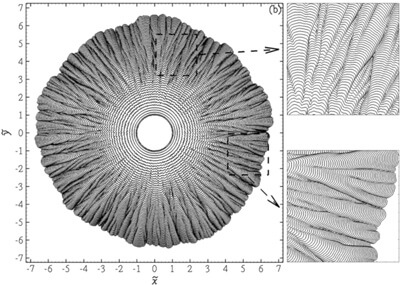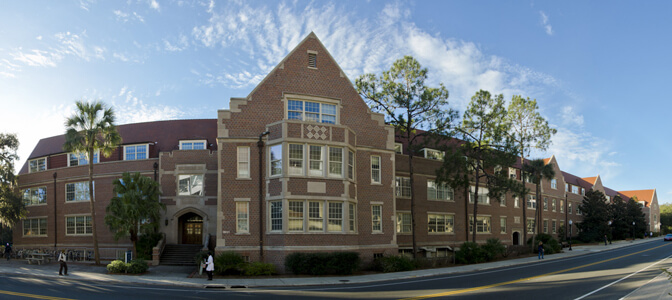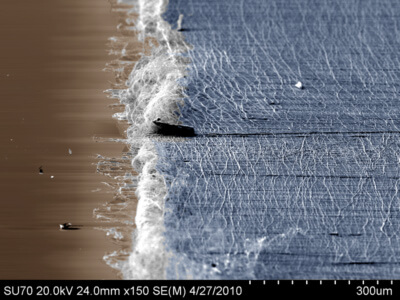UF High Performance Computing
One of the primary functions of ICE is to leverage the institutional investment made by the University of Florida towards its computational and networking infrastructure. In particular, ICE will strive to better connect the large-scale computational needs of the engineering faculty and students with the resources available on campus through the UF High Performance Computing Center.
The HPC Center at University of Florida runs clusters with about 6,500 cores in multi-core servers. The servers are part of one of two distinct InfiniBand fabrics. The clusters share over 200 terabytes of distributed storage via the Lustre parallel file system. In addition, the HPC Center houses about 1 PB of storage. The HPC Center has operated a small cluster with Tesla GPUs for experimental research and training. Recently the HPC Center has deployed two larger clusters with 16 Fermi GPUs and another with 32 GPUs. The clusters are connected by the 20 gigabit per second Campus Research Network (CRN), which was created as part of a NSF Major Research Instrumentation award and has been maintained by the University and the HPC Center. The CRN connects the HPC center to the Florida Lambda Rail, from which the National Lambda Rail and Internet2 are accessible. The UF HPC provides a good platform for the proposed microscale and mesoscale simulations for development, testing and performing preliminary simulations on O(100) to O(1000) cores, before accessing DOD supercomputing facilities.
UF HPC has joined forces with four other universities in the state of Florida to form the Sunshine State Education & Research Computing Alliance (SSERCA) to build a robust cyber-infrastructure and to share expertise and resources. The Florida Lambda Rail (FLR) provides the underlying fiber optic network and network connectivity.
Biomedical Engineering
The fundamental mission of the Biomedical Engineering Department at the University of Florida is to better the world and improve the human condition through interdisciplinary and creative merging of engineering with biology and medicine.
Chemical Engineering
The department is part of one of the largest and highest ranked Engineering Colleges and Universities in the southeastern region. Its research and educational activities are not hindered by Departmental or College boundaries, as many faculty either lead or are active in multidisciplinary centers, such as the Florida Energy Systems Consortium, the Particle Engineering Research Center, the Nanoscience Institute for Medical and Engineering Technology.

Computer and Information Science and Engineering (CISE)
The Department of Computer and Information Science and Engineering is concerned with the theory, design, development and application of computer systems and information processing techniques. The mission of the CISE Department is to educate undergraduate and graduate majors as well as the broader campus community in the fundamental concepts of the computing discipline, to create and disseminate computing knowledge and technology, and to use our expertise in computing to help society solve problems.
Electrical & Computer Engineering (ECE)
The Department of Electrical & Computer Engineering at the University of Florida is located in Gainesville, one of the fastest growing technology centers in the United States as well as the cultural, educational and commercial center for the North Central Florida Region. ECE helps to spur this growth through innovative research, educational and commercialization activities that expand beyond the city’s borders.
ESSIE – Engineering School of Sustainable Infrastructure & Environment
The school is at the cutting edge of integrating civil, coastal & oceanographic engineering; and environmental engineering sciences. The mission of ESSIE is to pioneer research, education and sustainable, environmentally responsible, and eco-friendly engineering technologies.
Industrial & Systems Engineering
Industrial and Systems Engineering integrates analytical programs with application areas in manufacturing, logistics and supply chain management with decision support systems with the soft skills that include presentation, teaming and business skills. Essentially, our students learn to recognize and understand a problem, develop a solution algorithm, implement it through the appropriate decision-support system, and “sell†it to the client. It is a great combination of skills that is in demand by countless companies in numerous industries.
Materials Science and Engineering
The department stands among the best materials, metallurgy and ceramics departments in the nation, with current research expenditures of over $10 million a year from external contracts and grants. With the firm belief that research is teaching, students are involved in almost every research and development project. The program is interdisciplinary, focusing on all materials – biomaterials, ceramics, electronic materials, glasses, metals, minerals and polymers, among others – and their composites. An excellent working relationship has been established between the department, industry and national labs to foster technology transfer, research and development.
Mechanical and Aerospace Engineering (MAE)
The Mechanical & Aerospace Engineering department defines four objectives as the cornerstones of its mission. The first objective is naturally education. As an outstanding department in a top tier university, the department has an obligation to provide exceptional educational experiences to its students at the BS, MS, and PhD levels.
Nuclear Engineering
The Nuclear Engineering Program was integrated into the UF Department of Materials Science and Engineering (MSE) in 2011. This unique configuration provides a vibrant, multidisciplinary and highly collaborative environment. The department includes 35 faculty members, over 250 graduate students, over 340 undergraduates (undergraduates are approximately equally split between the NE and MSE programs), and over $12 million in annual research expenditures.


